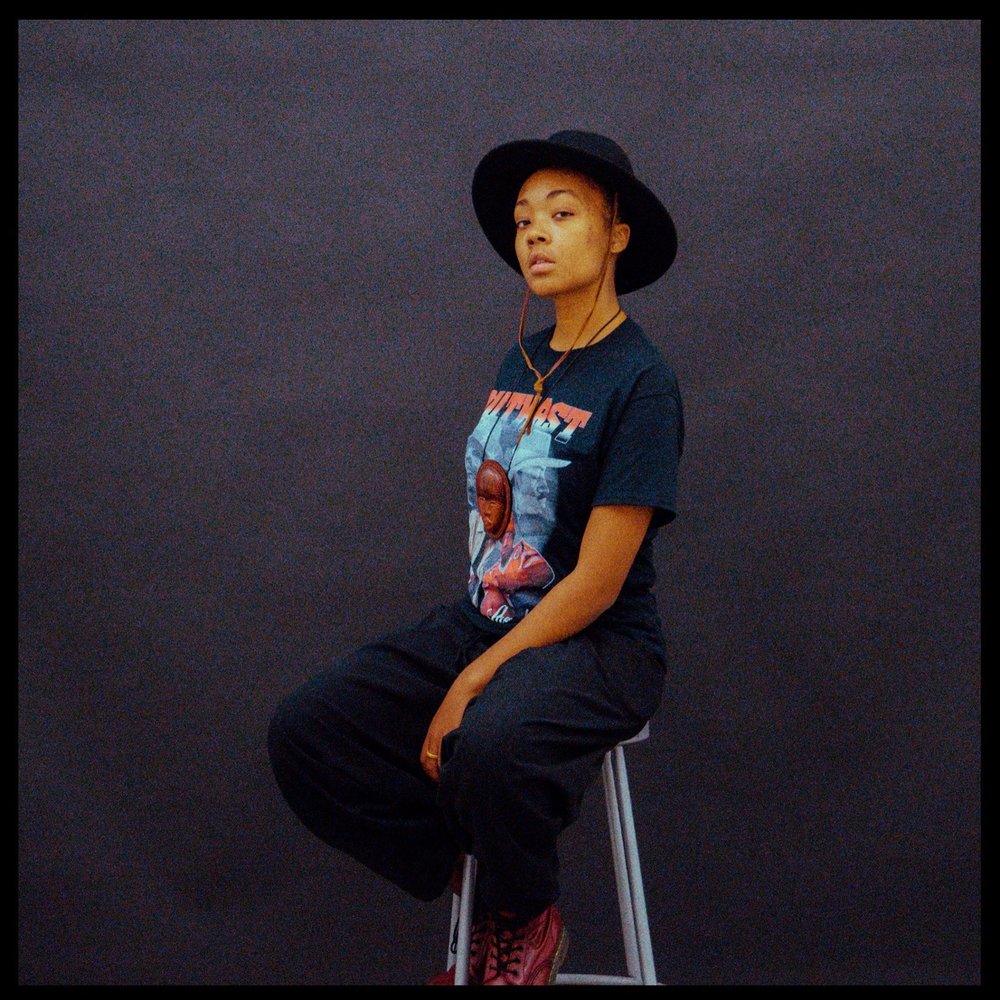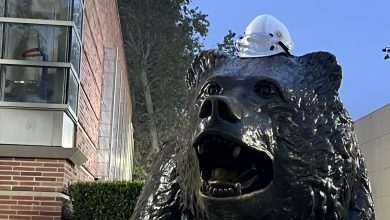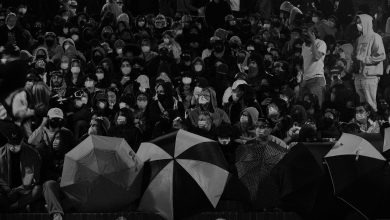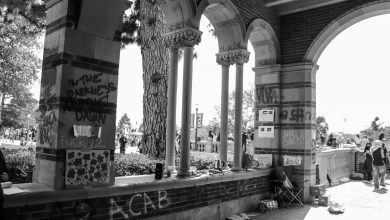Kya Lou asks, “What Do You Do ‘Fore It’s Gone?”

Image courtesy of Kya Lou
Imagine your childhood home. Imagine the street on which you and your family live. Imagine your neighbors. Imagine your community, the familiarity and warmth fostered from years of daily interaction. Now, imagine that taken away from you.
It is a devastating reality for several inner-city communities around Los Angeles, where gentrification transforms the cultural face and value of predominately Black and Latino neighborhoods for the sake of capital. UCLA art major Kya Lou’s exhibit “What Do You Do ‘fore It’s Gone?” examines the space between the settlement and upheaval of historically Black neighborhoods in South Los Angeles. Through use of audio, text, video, photography and textiles, Kya Lou foregrounds the concerns of citizens whose voices often go neglected, with the goal of fostering dialogue about the meaning of community. With “What Do You Do ‘fore It’s Gone?” Kya Lou creates space for an issue that concerns the loss of space.
I sat down with Kya Lou to discuss the exhibit, the process, and her inspirations:
Can you explain your process?
I’m very private. I like to work in privacy, on my laptop, in the comfort of my home. But I can also work in a Lyft ride, or at a coffee shop. I don’t really work with other people. I don’t ask a lot of people for input, like “What do you think of this?” and then go and make those changes. I’m very independent when it comes to my work, and I’m pretty comfortable with that. I listen to what other people have to say about my work…I’m still influenced by what everybody else is saying, but at the same time, when it comes to the actual creation of the work, I’m very private about it. There’s a lot of stuff that I don’t share, for months, even a year. I like to take as much time with the piece as I can, and pay attention to every single detail and aspect of the piece. Like, I really wanna know it like the back of my own hand, and to understand like, how did I even get to this piece?
So when you say, “how did I get to this piece,” are you talking about the subject and subject matter?
Yeah, subject matter in terms of, how did I get to this environment? What brought me to this environment? A lot of the time the neighborhoods I focus on are predominately Black, and I focus on these neighborhoods because a lot of my time throughout the week is spent at UCLA, and there’s not a lot of Black people. I don’t get to experience Blackness in the way that I want to, so I travel out to Leimert Park to search for that, and to experience that. Coming from San Diego, there is a Black population, but there’s no concentrated Black neighborhood like there is in Leimert Park or Compton, or other areas throughout Los Angeles. And there’s not really a Black arts scene in San Diego. It’s a much smaller city, so the first time I went to Leimert Park, I was like, “Maan?! This is a thing?” Like, there’s a bunch of Black-owned businesses, Black entrepreneurs, Black street vendors all in one area, and that doesn’t exist back home, y’know? Discovering Leimert Park for myself was super exciting.
I often ask myself, what influenced me to come here and take photographs today? Why did I ask this particular person to take a photograph? A lot of people, I didn’t know them until I took their picture. I saw them and I liked the way that the light was hitting their face, or I had interest in what they were doing. Or, something about their character made me gravitate towards them. I’m not afraid to try and position somebody outside whatever stance I first saw them. I’m not afraid to do that, and I wonder why I’m not afraid to do that. Why am I so interested in telling somebody else’s story? In trying to capture a moment in their own journey, and create something?
I went to the exhibit and I noticed that there aren’t any people in the photographs. You focus on the architecture. Can you talk about that decision a bit more?
The piece was originally for a class, a new genres class, taught by Andrea Fraser. I was interested in talking about gentrification in the way I have come to understand it, how it operates in the communities I’m most familiar with. Even though I’m not from Los Angeles, or South Central Los Angeles, or Leimert Park, I still have a connection to that neighborhood as if it was my own. I’ve been watching for the past three years—I have family that lives in the neighborhood. I’ve always felt like I have a home whenever I’m in Leimert. With that said, watching the installation of the new Metro Line, seeing businesses that I saw three years ago disappear…along Crenshaw Boulevard, it’s not just one block where property’s been bought out, but several blocks. There’s a similar thing happening in Boyle Heights. Like, I can’t just ignore these signs.
So the question is, what do you do in this situation? You can’t stop the Metro Line from being built, it’s supposed to completed in 2019. I don’t know how much money’s gone into the project. I don’t have the money to say, “No, you guys can’t do this.” So, I thought of what I could do before what I know is gone. What do you do in this process of things being taken away from you, and you don’t have much of a say in that process? The exhibit was my response to what I have been seeing—documenting what’s currently going on, telling other people that aren’t familiar with the neighborhood of this process, giving a language to people that may not understand what gentrification is.
The title of the exhibit has a connection to Solange’s “Where Do We Go.” You mentioned that even though you’re not from Los Angeles, you still feel like this is home. How does the song relate to your work and to the larger conversation surrounding Black communities?
I find it interesting—how we take what we listen to and implement it into our own work, whether we’re conscious of it or not. It’s interesting how the language used in the name of the exhibition is relatable to the language used within the song. But there are other influences. Lorna Simpson—how she uses language in her work, and also how Spike Lee uses language. Thinking about the Black vernacular—some people refer to it as Ebonics—I don’t know how I refer to it, but we do have a certain way of communicating.
Isn’t it also called AAVE?
Yeah, I read that term recently on a blog. But I’ve always known it as a Black vernacular or slang—there’s many ways to talk about it, or describe it. I’m very interested in using that way of communicating in my work because naturally that’s how I communicate. I’m not going to try and come up with some language or verbiage that I can’t even comprehend myself. I am conscious of my audience, who I am creating for, who I want to see this. How do they communicate? I want to communicate the same way, and be as natural as possible. I want to communicate that through my art.
Your use of movie clips was interesting. You have the West Coast perspective with “Boyz N’ the Hood” and the East Coast perspective with “Do the Right Thing.” It connects to Mickalene Thomas’s recent exhibition “Do I Look Like a Lady” in that your exhibit and hers use video in a way that creates dissonance—well, maybe not dissonance, but synchronization.
I get a lot of understanding of things through mass media. Who you are as a person isn’t just what you eat, it’s what you listen to, it’s what you watch, it’s what you read. A lot of my own knowledge has been taken from music and movies. When it came to figuring how I could define gentrification, I looked to movies. There’s so much knowledge in a movie—knowledge whether you agree with it or not. I decided to go through Youtube and looked up TEDxTalks, videos related to Boyle Heights, but ultimately, I wanted something recognizable.
It’s interesting that both films were made during the same era. It caused me to wonder, how long have we been talking about this? I’m here in 2017 talking about this, they were in the late 80’s, early 90’s talking about this. Both movies are played frequently on BET and other networks—how long have we been talking about this? How long has this been happening? It’s crazy how we’ve been talking about this for so long, wondering when are we gonna be heard? Will we ever be heard? Or, are we being heard, but just ignored?
Your exhibition seems interested in exploring the tension between a non-Western culture in a Western world. There seems to be an idea of playing around with facades, literal and figurative.
The culture is there. The people are still there. The businesses or the places that used to exist, or how they used to exist isn’t. Leimert Park is still a very vibrant, fun neighborhood. You can go there and have a great time and go home with Caribbean food or Jamaican patties that are bomb as heck that I love! You can still experience the culture; it just may not exist in the way that it used to.
There’s a vibrant culture that’s found in the people, but not necessarily the buildings. The buildings you capture—they haven’t been renovated, they’re in a state of disrepair. Having these buildings that are in disrepair, but also having this culture that is very vibrant. I’m noticing a tension there. There’s one image in particular that you took of a storefront that’s completely empty, but you can see your shadow. There’s a haunted quality to it.
I’m still trying to figure out how I feel about that photo. The larger idea is that we’re still present, but it may not be as pretty—pretty’s a problematic word. It’s not the standard definition of beauty when you think of neighborhoods, or the image that comes to mind when you think of a beautiful Black neighborhood that embraces African culture. You’re not gonna think of empty buildings. There are businesses in Leimert Park, but there’s also empty buildings. There’s vendors, there’s music, but it’s not a huge African Arts fest all the time, y’know what I mean?
Who are some of your favorite artists? You had mentioned Lorna Simpson and Spike Lee before—
Yeah, I have many. I pull from the visual arts, but music inspires me as well. I feel like photography is music, too. Sun Ra talked a lot about this theory that says anything that makes you feel something is music—whether it be photography or a beautiful painting. I like a lot of old school rap—Redman, Method Man, Wu-Tang Clan, Biggie Smalls. Local Los Angeles artists like Dana Washington. Carrie Mae Weems—her stuff is amazing, dope. Mickalene Thomas, her exhibit at the MOCA—I was taken aback. When I entered the room, I was like, “Whoa! This is crazy!” Even the people I follow on Instagram, though I can’t remember their names right now.
“What Do You Do ‘fore It’s Gone?” does not arrive at easy conclusions. However, in the face of loss and upheaval, it calls for the strengthening of love for one’s community and culture.




